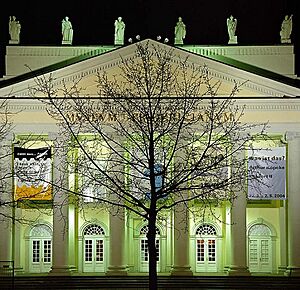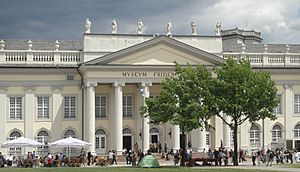Documenta facts for kids
Documenta is a very important art show that happens every five years in Kassel, Germany. It features contemporary art, which means art made in our time.
This big art event was started in 1955 by an artist and teacher named Arnold Bode. He wanted to help Germany reconnect with modern art after the dark period of Nazism, when many types of art were banned. The first Documenta showed works by famous artists like Picasso and Kandinsky. Today, Documenta includes artists from all over the world. Many of the artworks are also made specifically for the places where they are shown in Kassel.
Every Documenta exhibition lasts for exactly 100 days. That's why people sometimes call it the "museum of 100 days." It's important to know that Documenta is not a place where art is sold.
Contents
What Does "Documenta" Mean?
The name Documenta was made up. It comes from the idea of "documenting" or recording modern art. This was especially important for the first show in 1955. At that time, modern art had been hidden from the German public during the Nazi era.
Some people close to Arnold Bode said the name was also inspired by the Latin word documentum. This word can be split into docere (meaning 'to teach') and mens (meaning 'intellect'). So, the name was thought to describe Documenta's goal to teach and inspire minds.
Each Documenta exhibition has its own unique look and style. Most of them use only lowercase letters for their titles. This style came from the famous Bauhaus art school.
History of Documenta

The first Documenta was started by Arnold Bode, an art professor from Kassel. It was originally planned as a smaller event during a garden show in 1955. But it became very popular, attracting over 130,000 visitors!
This first show focused on art that had been called "Entartete Kunst" (meaning "degenerate art") by the Nazis. This included styles like Fauvism, Expressionism, Cubism, and abstract art. Bode wanted to reintroduce these important art movements to the public.
Over time, Documenta started to focus more on truly contemporary art. At first, it only showed art from Europe. But soon, it included artists from the Americas, Africa, and Asia.
- The 4. documenta (1968) was the first to make a profit. It showed pop art, minimal art, and kinetic art.
- The 1972 Documenta, called documenta 5, changed how people thought about art. It featured minimal and conceptual art. It also showed works by Adolf Wolfli, a unique Swiss artist. Joseph Beuys also performed there, sharing his ideas about democracy.
- In 1987, documenta 8 showed that design could also be considered art.
- documenta X (1997) looked at how art explored political, social, and cultural changes, especially around important dates like 1945.
- Documenta11 (2002) focused on themes like migration and city life. It featured lots of photography, film, and video from many different places.
- documenta (13) in 2012 was described as being very global and using many different types of media. It also included works by artists who had passed away and some ancient art.
Who Directs Documenta?
The first four Documenta shows were organized by Arnold Bode. They helped the exhibition become famous worldwide. Since the fifth Documenta in 1972, a new artistic director is chosen for each show. A group of art experts picks this director.
Sometimes, putting together a Documenta can be tricky. For example, Documenta 8 had to be planned in just two years instead of the usual five. The first directors couldn't agree and left. Other people had to step in to finish the show.
Catherine David was the first woman and the first non-German speaker to be the director for documenta X (1997). The first director from outside Europe was Okwui Enwezor for Documenta11 (2002).
The artistic director of Documenta earns about €100,000 each year.
| Title | Date | Director | Exhibitors | Exhibits | Visitors |
|---|---|---|---|---|---|
| documenta | 16 July – 18 September 1955 | Arnold Bode | 148 | 670 | 130,000 |
| II. documenta | 11 July – 11 October 1959 | Arnold Bode, Werner Haftmann | 338 | 1770 | 134,000 |
| documenta III | 27 June – 5 October 1964 | Arnold Bode, Werner Haftmann | 361 | 1450 | 200,000 |
| 4. documenta | 27 June – 6 October 1968 | 24-strong documenta council | 151 | 1000 | 220,000 |
| documenta 5 | 30 June – 8 October 1972 | Harald Szeemann | 218 | 820 | 228,621 |
| documenta 6 | 24 June – 2 October 1977 | Manfred Schneckenburger | 622 | 2700 | 343,410 |
| documenta 7 | 19 June – 28 September 1982 | Rudi Fuchs | 182 | 1000 | 378,691 |
| documenta 8 | 12 June – 20 September 1987 | Manfred Schneckenburger | 150 | 600 | 474,417 |
| documenta IX | 12 June – 20 September 1992 | Jan Hoet | 189 | 1000 | 603,456 |
| documenta X | 21 June – 28 September 1997 | Catherine David | 120 | 700 | 628,776 |
| documenta11 | 8 June – 15 September 2002 | Okwui Enwezor | 118 | 450 | 650,924 |
| documenta 12 | 16 June – 23 September 2007 | Roger M. Buergel/Ruth Noack | 114 | over 500 | 754,301 |
| documenta (13) | 9 June – 16 September 2012 | Carolyn Christov-Bakargiev | 187 | 904,992 | |
| documenta 14 | 8 April – 16 July 2017 in Athens, Greece; 10 June – 17 September 2017 in Kassel |
Adam Szymczyk | more than 160 | 1500 | 339,000 in Athens 891,500 in Kassel |
| documenta fifteen | 18 June 2022 – 25 September 2022 in Kassel | ruangrupa | more than 67 | ||
| documenta 16 | 2027 | Naomi Beckwith |
The 2012 Documenta (documenta (13)) had a unique idea. It was based on the meeting of two different people in the United Arab Emirates. This idea explored how people connect globally and how digital tools can change relationships.
Where Documenta Takes Place
Documenta uses several different places in Kassel for its exhibitions. The main building since 1955 has been the Fridericianum. The documenta-Halle was built in 1992 for documenta IX and is still used today.
Other places that have hosted Documenta art include the Karlsaue park, Schloss Wilhelmshöhe, the Neue Galerie, the Ottoneum, and the Kulturzentrum Schlachthof.
For Documenta11, director Okwui Enwezor wanted to move away from a European-only focus. He set up five "platforms" or smaller events before the main show. These took place in cities like Vienna, Berlin, New Delhi, St Lucia, and Lagos. This helped bring in new ideas and art from different parts of the world.
Many artworks are also shown outdoors, especially in Friedrichsplatz (the square in front of the Fridericianum) and the Karlsaue park. For documenta (13) in 2012, some artworks were even shown in places like Kabul, Afghanistan, and Banff, Canada.
Artworks That Stayed in Kassel
Some of the artworks shown at Documenta have been bought and kept in Kassel's museums. These become permanent parts of the city's art collection.
Examples include:
- 7000 Eichen (7000 Oaks) by Joseph Beuys
- Rahmenbau (1977) by Haus-Rucker-Co
- Laserscape Kassel (1977) by Horst H. Baumann
- Traumschiff Tante Olga (1977) by Anatol Herzfeld
- Vertikaler Erdkilometer (Vertical Earth Kilometer) by Walter De Maria
- Spitzhacke (Pickaxe) (1982) by Claes Oldenburg
- Man walking to the sky (1992) by Jonathan Borofsky
- Fremde (Strangers) (1992) by Thomas Schütte (parts of this are on buildings in Kassel and Lübeck)
The Documenta Archive
Because so much information and material is created for each Documenta, Arnold Bode started an archive in 1961. This archive keeps all the files and materials from the Documenta organization. It also has a growing collection of videos and images. The personal collections of Arnold Bode and artist Harry Kramer are also part of this important archive.
How Documenta is Managed
Visitors to Documenta
In 1992, for documenta IX, more than half a million people visited Kassel for the exhibition. This was a first for Documenta! The 2002 show attracted 650,000 visitors, which is more than three times the population of Kassel itself.
In 2007, documenta 12 had 754,000 paying visitors. More than a third of these visitors came from other countries, especially from nearby Netherlands, France, Belgium, and Austria. The 2012 exhibition, documenta (13), welcomed 904,992 visitors.
Documenta's Budget
In 2007, Documenta's budget was about 19 million euros (around $25.7 million). Half of this money came from the city of Kassel, the state of Hessen, and Germany's national cultural foundation. The rest of the money came from sponsors, donors, and ticket sales.
The budget for Documenta 14 (2017) was about 37 million euros ($40 million). However, the exhibition ended up spending more than planned, especially for the part of the show held in Athens. This led to a financial shortage. The city of Kassel and the state of Hesse had to provide emergency loans to help.
See also
 In Spanish: Documenta para niños
In Spanish: Documenta para niños




